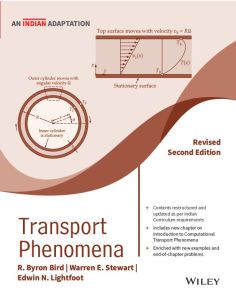Transport Phenomena, Revised 2ed (An Indian Adaptation)
ISBN: 9789354244452
932 pages
For more information write to us at: acadmktg@wiley.com

Description
Transport Phenomena is a well-established textbook that presents the three topics momentum, heat, and mass transport; and provides an analogous approach to studying these three topics. It is specifically designed for undergraduate and postgraduate level in the Chemical Engineering curriculum. The textbook is centered around these topics covering the basics mechanisms, shell balance approach to develop governing equations, development, and application of equation of change to find the velocity and/or temperature and/or concentration profile, and macroscopic approach of transport phenomena.
Preface to the Adapted Edition
About the Adapting Authors
Preface
Chapter 0 Introduction to Transport Phenomena
- What are the Transport Phenomena?
- Mechanisms of Transport Phenomena
- Three Levels at Which Transport Phenomena can be Studied
- The Concept of a Continuum
- Conservation Laws: Mass, Momentum

